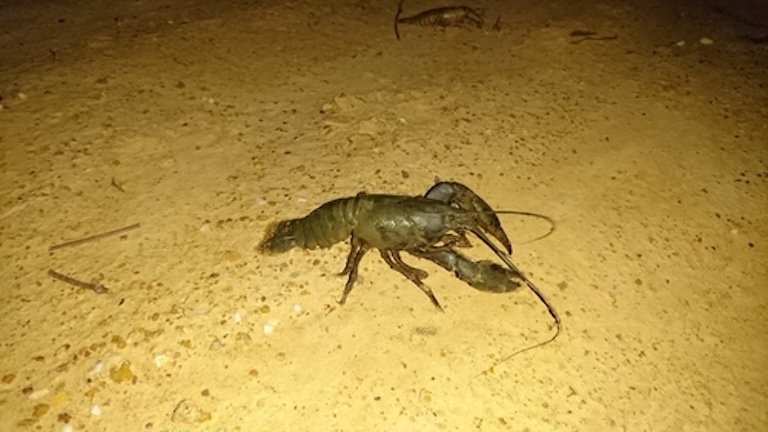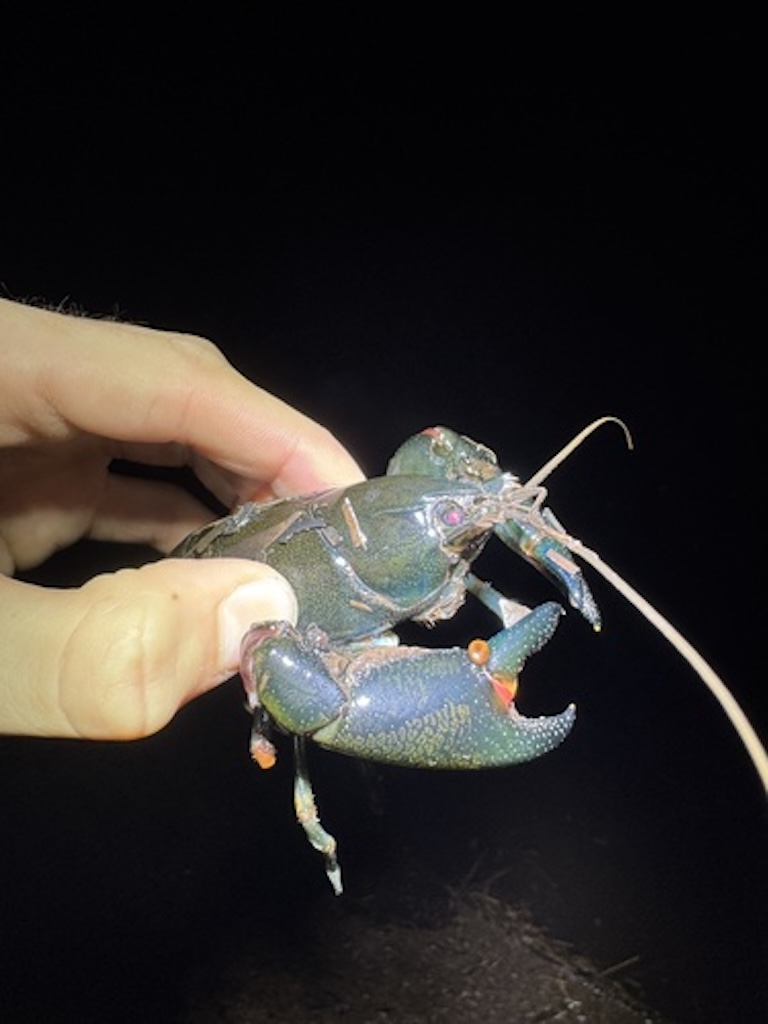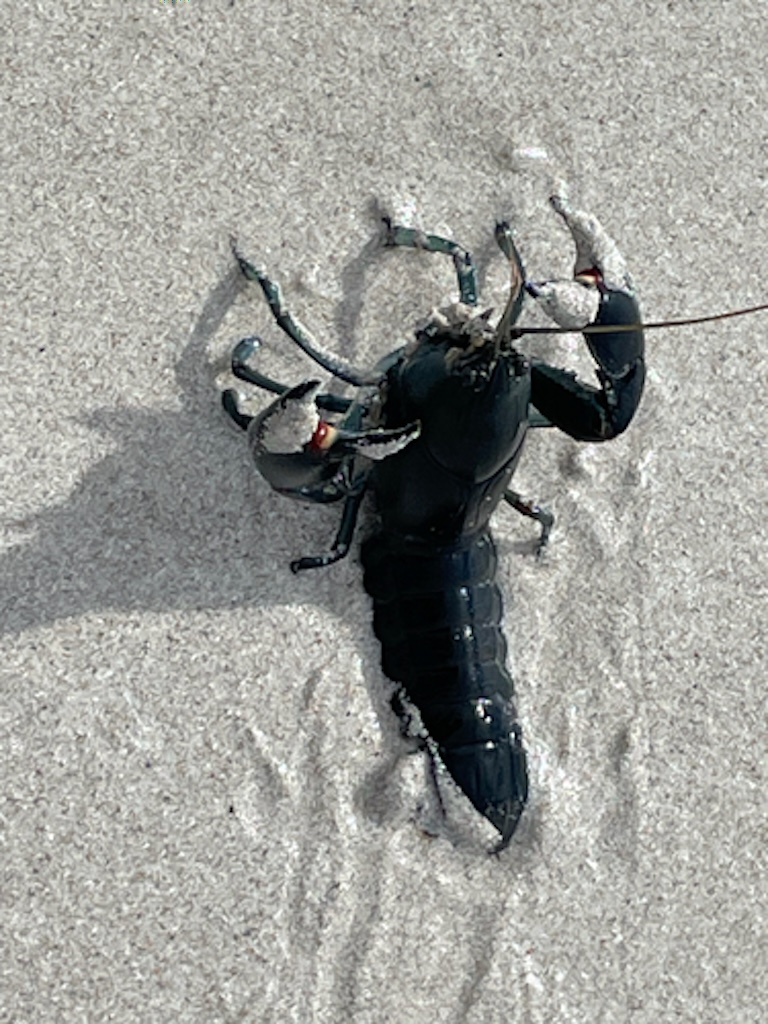Yabby Profile
There are two animals commonly referred to as a Yabby, one of them is Trypaea, a genus of marine ghost shrimp called the Ghost Yabby, or Marine Yabby.
The other one, and the one this piece is about, is a popular genus of freshwater crayfish that likes to fight.

Yabby Facts Overview
| Habitat: | Slow moving or still waters: lagoons and back-waters, swamps, streams, rivers, reservoirs, and farm dams |
| Location: | Australia, and New Guinea |
| Lifespan: | Up to 7 years |
| Size: | Up to 30 cm (12 in), usually average of about half this |
| Weight: | Up to 300g (10.6 oz) |
| Colour: | Black, blue-black, or dark brown in clear waters to light brown, green-brown, or beige |
| Diet: | Opportunistic generalist scavengers/Detritivores. Vegetation to carrion |
| Predators: | Birds, fish, platypus |
| Top Speed: | Not recorded |
| No. of Species: | 60 |
| Conservation Status: | From Least Concern to Critically Endangered, depending on species. |
The name Yabby, as you might have guessed, comes from one of the many really fun-sounding languages of the Aboriginal peoples of Australia. These languages are where we get words like billabong, boomerang, numbat, quokka, and wallaby, to name a few.
So, the yabby is in good company, and has branched out from its native lands of Australia and New Guinea to now be found in aquaria all over the world. They’re cute, colourful, and aggressive, and people love them.
Interesting Yabby Facts
1. They’re Freshwater Crayfish
The yabby is a member of the Parastacidae family, which contains the Southern Hemishpere crayfish. These animals originate from Gondwana, the supercontinent that once contained most of the Southern Hemisphere’s current landmass (And India, which fled North suspiciously fast after the breakup).
Animals that evolved here are therefore often found on these now-separated landmasses, and the Yabby is a perfect example of this.
Being a common name, the word Yabby actually refers to more than one type of snappy little critter, the other being a marine ghost shrimp of around the same size, which is called a marine yabby. But being a completely different animal, that should get its own blog post.
Freshwater Yabbies were found on Antarctica before it was cool, but are now mostly found in Australia, with a few of the 62 or so species also found in New Guinea. They’re also some of the largest of the group!

2. They’re large
The genus Cherax is what people are referring to when they say Yabby, and it contains some fairly big crayfish. The largest grow up to around 30 cm long, and can pack a serious pinch, though the majority are closer to 15 cm long.
Some have even been bred to eat!1
Still, it’s not the size or the flavour that makes them so popular, it’s the colour.
3. They come in many flavours
Yabbies exhibit a wide range of colours, even within the same species. Habitat and water quality play a role in this colouration, and can affect whether the animal is blue, black, brown or beige.
Some, like Cherax pulcher, are even named for their beauty, and are a stunning mix of blues, pinks, and, greens and cream colours.
And the more well known this genus becomes, the more colours become available.
4. They’re popular in aquariums
Having been popularised for their prettiness, this genus is now very common in crustacean tanks in the homes of hobbyists all over the world.
Captive breeding by the same collectors has led to a strain of bright blue yabby that’s now one of the most popular, most commonly – and ironically – from the white yabby, Cherax albidus, which has been bred into colours like electric blue and “Blue pearl”. 2
5. But They’re grumpy buggers
And this is how we find out what jerks they can be.
Yabbies kept together don’t like each other all that much. Males, in particular, are very territorial, and while they’re well armoured against yabby attacks most of the time, they are vulnerable after shedding their skins, which is when they can be killed by rivals.
Of course, this moralistic judgement is not really ours to make if we’re keeping wild animals in tanks in ways that they wouldn’t be forced to live in their natural habitats, so it is worth remembering that they do have a genuine role in their ecosystem, and aren’t simply ornaments for our amusement.
6. They can walk
And as wild animals, they have impressive adaptations to their natural environments.
For example, when the water levels rise after the dry season, these crayfish are said to be able to venture out of their watery pools and across land, even for several kilometres, in search of new ground.
So, perhaps yabbies are more inclined to leave an area than fight each other, when they can.
7. They can wait
And when the rains stop and the dry season returns, they have an adaptation for this, too.
Yabbies can go into a form of hibernation called aestivation. This allows what is a purely aquatic animal to live in places where water doesn’t even exist all year ‘round. They do this the same way lungfish do: by burrowing into the mud and waiting.
8. They exhibit isometric growth
If you’ve ever wondered why baby animals can be so cute, it has a lot to do with their proportions. In mammals, it’s often the head, ears and feet and eyes that come out closer to full size, and make them look sort of like bobble-headed cartoon animals until the rest of their body catches up.
We’re hard wired to recognise these proportions as “Baby proportions” and for many, this elicits the universal “Aww” response accordingly.
This is a product of what’s called allometric growth, in which the proportions of the animal change over time.
The opposite of this is known as isometric growth, and it’s what animals like Yabbies exhibit. This is where the babies are proportionally identical to the adults and the only thing that changes over time is their size.
This can elicit an “Aww” response, too, as is the case even with baby pineapples for some reason, but it’s a very different kind of cuteness. Yabby babies are hatched after abouth a month of being held as eggs under the female’s tails and come out as fully-formed mini yabbies, eager to grow up.
8. Some are in trouble
Of the 21 species listed on the IUCN’s Red List, 2 are now Critically Endangered.
Cherax leckii is threatened by livestock farming, where cattle trample on their burrows in the mud and pesticides and herbicides pollute the waterways when they return.3
And Cherax tenuimanus is faced with competition with a very similar species, Cherax cainii, which has replaced C. tenuimanus in much of its range as well as breeding with it to produce a subgroup of hybrids whose future is uncertain.4

Yabby Fact-File Summary
Scientific Classification
| Kingdom: | Animalia |
| Phylum: | Arthropoda |
| Class: | Malacostraca |
| Order: | Decapoda |
| Family: | Parastacidae |
| Genus: | Cherax |
| Species Name: | 60+ |
Fact Sources & References
- (2025), “Cherax quadricarinatus”, Aquarium Glaser.
- , “Blue Pearl Crayfish (Cherax albidus) – Tank-Bred! ”, Aquatic Arts.
- (2009), “Cherax leckii”, IUCN Red List.
- (2010), “Cherax tenuimanus”, IUCN Red List.
